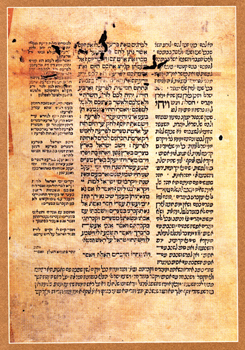


 |
Collection Jacob M. Lowy
Hamishah Humshe Torah. Pentateuque. Híjar (Aragon) : Éliézer Alantansi, pour Salomon ben Maïmon Zalmati, 1490.
Ce fragment de parchemin provient d'un Humash, le dernier livre en hébreu connu, daté et imprimé en Espagne avant l'expulsion. Cet ouvrage est également la première édition espagnole du Targum Onkelos et du commentaire de Rashi. Bien qu'on omit la difficile tâche typographique de vocalisation, l'imprimeur Alantansi utilisa trois types de caractères afin de distinguer le texte biblique (de larges caractères carrés) de la traduction araméenne (des caractères carrés plus petits) et du commentaire hébreu (cursives sépharades). Plus tard, on repassa minutieusement à la main, à l'encre, les voyelles et les signes de cantilation en voie de s'effacer. Le livre est ouvert sur Bereshit 46:32- (La Genèse 46:32-) : Joseph et les Israélites deviennent les esclaves du pharaon en Égypte.
This parchment fragment is from a Humash, the last known dated Hebrew book printed in Spain before the expulsion. It is also the first Spanish edition to carry both Targum Onkelos and the commentary of Rashi. Although the typographically difficult task of vocalization was omitted, printer Alantansi used three fonts to distinguish the biblical text (large square type) from the Aramaic translation (smaller square type) and the Hebrew commentary (Sephardic cursive). A later hand has painstakingly inked in the fading vocalization and cantillation signs. The text is open to Bereshit 46:32- (Genesis 46:32-): Joseph and the Israelites become bondsmen to Pharaoh in Egypt.
